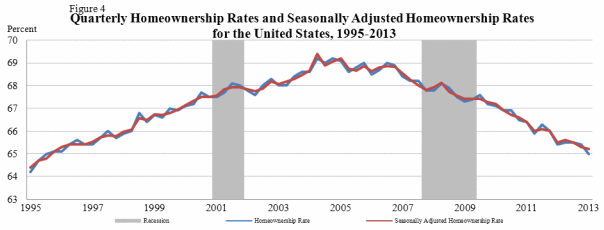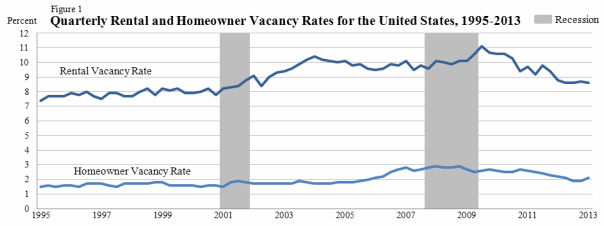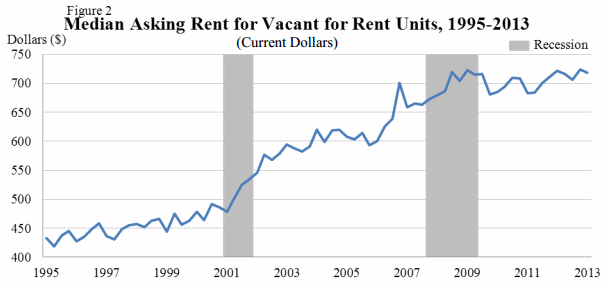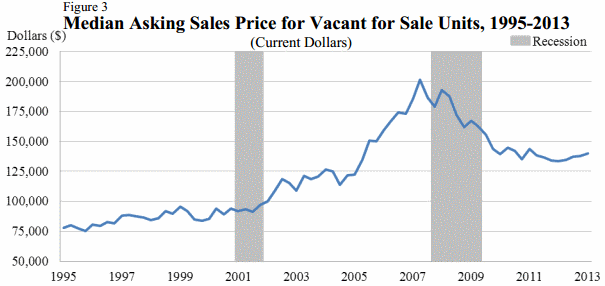Blog

Homeownership Hits 17-year Low
The U.S. vacancy rate and the rate ofrnhomeownership both declined in the first quarter of 2013 with the homeownershiprnrate hitting the lowest level in 17 years. rnAccording to the Census Bureau the rate of homeownership in the countryrndeclined from 65.6 in the fourth quarter of 2012 to 65.2. The rate in the first quarter of 2012 wasrn65.5 percent. The first quarter 2013rnrate is the lowest rate since the fourth quarter of 1995 when it was 65.1. The vacancy rate was 8.6 percent, 0.2rnpercentage points lower than one year earlier and 0.1 percentage point lowerrnthan in the fourth quarter of 2012. </p
 </p
</p
There were 133.08 million housing unitsrnin the U.S. in the first quarter, an increase of 486,000 from one yearrnearlier. Of those 114,643 were occupied,rnan increase of 520,000 and 18.4 million were vacant, essentially unchanged fromrnthe year before. Of the total housingrnstock 74.5 million units or 56 percent were owner occupied and 46.1 million orrn30.2 percent were occupied by renters.</p
 </p
</p
Vacant housing stock represents 13.9rnpercent of the total and 10.5 percent is considered to be year-round housingrnwhile 3.4 percent is for seasonal use. rnUnits for sale only make up 1.2 percent of housing stock and units for rentrn2.9 percent. For various reasonsrnincluding occasional use by the owner or a person with another usual residence,rn5.7 percent of stock was being held off of the market.</p
The vacancy rate for rental housing wasrnhigher inside of principal cities (8.6 percent) than in the suburbs (7.8rnpercent) and lower than the rate outside of metropolitan statistical areasrn(MSAs) (10.6 percent). The suburbanrnvacancy rate was down from a year earlier while rates inside of principal citiesrnand outside of MSAs did not change in a statistically significant manner. </p
The vacancy rate was higher in the Southrn(9.9 percent) than in the other three regions. rnThe Midwest had a rate of 9.5 percent while the Northeast was at 7.2rnpercent and the West was 6.9 percent. rnThe rate in the South was down from a year earlier while there wasrnlittle statistical difference between the periods in the other three regions.</p
The median asking price for vacantrnrental units in the first quarter was $718. rnThe median asking price for a vacant unit that was for sale wasrn$139,800.</p
 </p
</p
 </p
</p
Homeownership rates were lowest in thernWest at 59.4 percent, and highest in the Midwest at 70.0 percent, a pattern thatrnhas been in place since at least 2007. ThernNortheast rate was 62.5 percent and the South was 66.5 percent. The Midwest was the only region to post anrnincrease in homeownership on both a quarterly and annual basis.</p
As always the oldest age cohort, thosernover 65 years, had the highest homeownership rate at 80 percent and those underrn35 years the lowest rate at 36.8 percent. rnNon-Hispanic whites, again as usual, had the highest rate ofrnhomeownership at 73.4 followed by all other races at 54.6 percent, Hispanic atrn45.3, and Black alone 43.1 percent. Notrnsurprisingly households with family income equal to or greater than the medianrnhad a rate of 80.0 percent while those with incomes below the median had arnhomeownership rate of 50.0 percent.
All Content Copyright © 2003 – 2009 Brown House Media, Inc. All Rights Reserved.nReproduction in any form without permission of MortgageNewsDaily.com is prohibited.
Latest Articles
By John Gittelsohn August 24, 2020, 4:00 AM PDT Some of the largest real estate investors are walking away from Read More...
Late-Stage Delinquencies are SurgingAug 21 2020, 11:59AM Like the report from Black Knight earlier today, the second quarter National Delinquency Survey from the Read More...
Published by the Federal Reserve Bank of San FranciscoIt was recently published by the Federal Reserve Bank of San Francisco, which is about as official as you can Read More...

Comments
Leave a Comment